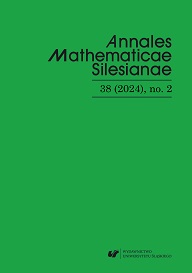J. Atkins and R. Geist, Fibonacci numbers and computer algorithms, College Math. J. 18 (1987), no. 4, 328–336.
Google Scholar
U. Bednarz, A. Włoch, and M. Wołowiec-Musiał, Distance Fibonacci numbers, their interpretations and matrix generators, Comm. Math. 53 (2013), no 1, 35–46.
Google Scholar
U. Bednarz, I. Włoch, and M. Wołowiec-Musiał, Total graph interpretation of the numbers of the Fibonacci type, J. Appl. Math. (2015), Art. ID 837917, 7 pp.
Google Scholar
D. Bród, K. Piejko, and I. Włoch, Distance Fibonacci numbers, distance Lucas numbers and their applications, Ars Combin. 112 (2013), 397–409.
Google Scholar
D. Bród and A. Włoch, (2,k)-distance Fibonacci polynomials, Symmetry 13 (2021), no. 2, Paper No. 303, 10 pp.
Google Scholar
R. Diestel, Graph Theory, Springer-Verlag, Heidelberg-New York, 2005.
Google Scholar
M.C. Er, Sums of Fibonacci numbers by matrix methods, Fibonacci Quart. 22 (1984), no. 3, 204–207.
Google Scholar
S. Falcón, Binomial transform of the generalized k-Fibonacci numbers, Comm. Math. Appl. 10 (2019), no. 3, 643–651.
Google Scholar
S. Falcón and Á. Plaza, The k-Fibonacci sequence and the Pascal 2-triangle, Chaos Solitons Fractals 33 (2007), no. 1, 38–49.
Google Scholar
A.J. Feingold, A hyperbolic GCM Lie algebra and the Fibonacci numbers, Proc. Amer. Math. Soc. 80 (1980), no. 3, 379–385.
Google Scholar
M.L. Fredman and R.E. Tarjan, Fibonacci heaps and their uses in improved network optimization algorithms, J. Assoc. Comput. Mach. 34 (1987), no. 3, 596–615.
Google Scholar
A.F. Horadam, A generalized Fibonacci sequence, Amer. Math. Monthly 68 (1961), 455–459.
Google Scholar
D.V. Jaiswal, On a generalized Fibonacci sequence, Labdev–J. Sci. Tech. Part A 7 (1969), 67–71.
Google Scholar
E. Kiliç, The generalized order-k Fibonacci-Pell sequence by matrix methods, J. Comput. Appl. Math. 209 (2007), no. 2, 133–145.
Google Scholar
T. Koshy, Fibonacci and Lucas Numbers with Applications, Wiley-Interscience, New York, 2001.
Google Scholar
M. Kwaśnik and I. Włoch, The total number of generalized stable sets and kernels in graphs, Ars Combin. 55 (2000), 139–146.
Google Scholar
G.-Y. Lee, S.-G. Lee, J.-S. Kim, and H.-K. Shin, The Binet formula and representations of k-generalized Fibonacci numbers, Fibonacci Quart. 39 (2001), no. 2, 158–164.
Google Scholar
N.Y. Li and T. Mansour, An identity involving Narayana numbers, European J. Combin. 29 (2008), no. 3, 672–675.
Google Scholar
E. Özkan, B. Kuloğlu, and J.F. Peters, k-Narayana sequence self-similarity. Flip graph views of k-Narayana self-similarity, Chaos Solitons Fractals 153 (2021), Paper No. 111473, 11 pp.
Google Scholar
E. Özkan, N. Şeyma Yilmaz, and A. Włoch, On F_3(k,n)-numbers of the Fibonacci type, Bol. Soc. Mat. Mex. (3) 27 (2021), no. 3, Paper No. 77, 18 pp.
Google Scholar
G. Sburlati, Generalized Fibonacci sequences and linear congruences, Fibonacci Quart. 40 (2002), no. 5, 446–452.
Google Scholar
M. Schork, Generalized Heisenberg algebras and k-generalized Fibonacci numbers, J. Phys. A 40 (2007), no. 15, 4207–4214.
Google Scholar
N.J.A. Sloane, The On-Line Encyclopedia of Integer Sequences. Available at https://oeis.org/book.html
Google Scholar
J. de Souza, E.M.F. Curado, and M.A. Rego-Monteiro, Generalized Heisenberg algebras and Fibonacci series, J. Phys. A 39 (2006), no. 33, 10415–10425.
Google Scholar
Y. Soykan, Generalized Fibonacci numbers: sum formulas, J. Adv. Math. Comp. Sci. 35 (2020), no. 1, 89–104.
Google Scholar
I. Stojmenovic, Recursive algorithms in computer science courses: Fibonacci numbers and binomial coefficients, IEEE Trans. Educ. 43 (2000), no. 3, 273–276.
Google Scholar
S. Wagner and I. Gutman, Maxima and minima of the Hosoya index and the Merrifield-Simmons index: a survey of results and techniques, Acta Appl. Math. 112 (2010), no. 3, 323–346.
Google Scholar
A. Włoch, Some identities for the generalized Fibonacci numbers and the generalized Lucas numbers, Appl. Math. Comput. 219 (2013), no. 10, 5564–5568.
Google Scholar
I. Włoch, U. Bednarz, D. Bród, A. Włoch, and M. Wołowiec-Musiał, On a new type of distance Fibonacci numbers, Discrete Appl. Math. 161 (2013), no. 16-17, 2695–2701.
Google Scholar
I. Włoch and A. Włoch, On some multinomial sums related to the Fibonacci type numbers, Tatra Mt. Math. Publ. 77 (2020), 99–108.
Google Scholar



 10.2478/amsil
10.2478/amsil